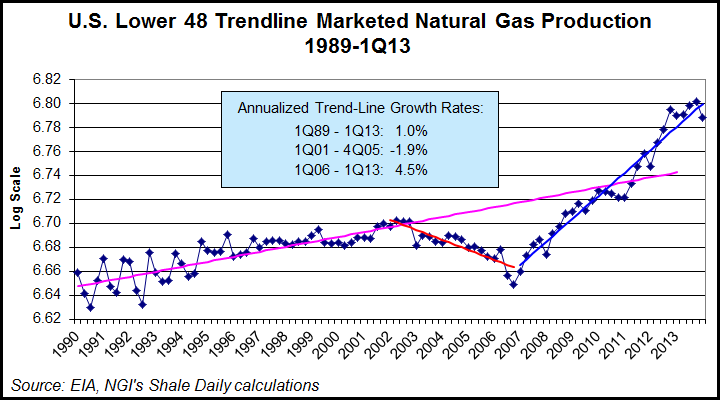NGI Archives | NGI All News Access
COGA Panel Says Unconventional Technology Still In Early Days
Technological innovations in the oil and gas industry have marked some remarkable discoveries over its 150-year history. Today, the innovations may be coming more quickly, but there’s still plenty to learn, energy stalwarts said Tuesday at the 25th Annual Rocky Mountain Energy Summit.

There’s still much to learn, for example, about how to perform hydraulic fracturing (fracking) in the most efficient way, said Liberty Resources LLC CEO Chris Wright. He doesn’t think North America’s shale revolution has even hit its stride.
“Industry has been innovative its entire history,” he said. “It’s been reinventing itself for 150 years…Dynamism has been flowing over the past 10-15 years. Now we are ‘seeing’ how fracks actually grow, which was enabled by rapid innovation…”
Technology gains are are “even faster now than before because more people are working on it,” he told the audience. “Some fractures are more equal than others. A specific approach drives huge variability in well performance…It continues to evolve, it continues to get better.”
Wright, like others before him, acknowledged that the shale gas revolution was driven by two things: the determination of George Mitchell and other pioneers, and through continuing technology development, which has given operators more access to resource identification, fracking innovations and horizontal wellbore strategy isolation.
The shale boom’s impact on U.S.natural gas is obvious when looking at production data. According to Energy Information Administration data, U.S. Lower 48 marketed natural gas production recorded an annualized trend-line decline rate of 1.9% from 1Q2001 to 4Q2005. However, with the shale gas surge coming online in 2007-2008, the annualized trend-line flipped to 4.5% in growth from 1Q2006 to 1Q2013 (see chart).
The shale oil revolution, spurred by high oil prices, followed on, using the shale gas technology.
Today, Wright and his crew use the same technologies to tap the oil-rich Bakken Shale, where wells now typically are two miles deep and two miles wide, with 35 frack stages and three-five fracks/stage. Even better, “we can get lots of oil and gas at very poor permeability with a large contact area.”
“The next big thing coming is something we won’t know until it happens.”
Norm Warpinski is a Halliburton Co. Fellow who works for affiliate Pinnacle Technologies. The one thing he knows for sure is that “the more complicated the reservoir, the more complicated the fracturing is going to be.”
Warpinski is involved in developing new tools and analyses for frack mapping, reservoir monitoring, frack designs and reservoir development.
“Many uncertainties remain” in unconventional drilling, particularly around fracking. “How many fractures were initiated in each stage? How much have we ‘activated’ the natural fractures? What part of this system is productive?” With each field, with each well, the answers may be completely different.
Several innovations Warpinski sees emerging:
“When all of these tools come into use, then we’ll know a lot more about hydraulic fracturing,” Warpinski said.
The use of proppants to stimulate fracks remains a point of contention and innovation as well, said Republic Energy’s Senior Geologist Dan Steward. He helped George Mitchell’s Mitchell Development and Energy Corp. to successfully tap into the Barnett Shale.
“In the early days of the Barnett,” Steward said, “we correlated the frack size to the amount of proppant we pumped. The more sand we put into the ground, the better the well. It also meant the longer the fracks…
“We have looked at water fracks, and there’s still disagreement in the industry on how important proppant is in some of the wells…” In the Barnett, “we were building superhighways on the shale surface, when maybe we only needed a trail…we had one well where were fracked the well with no water and no sand, and it looked as good as others around it. But I think sand is beneficial.”
The answer on how much to use remains elusive, as do other types of drilling techniques to produce more oil and gas at less cost and most efficiently. All of that is yet to come, he said.
© 2024 Natural Gas Intelligence. All rights reserved.
ISSN © 2577-9877 | ISSN © 2158-8023 |

